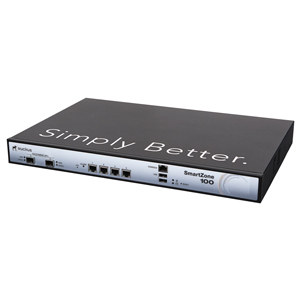
Ruckus Wireless has announced availability of version 3.5 of its SmartZone Operating System (OS). The release powers the industry’s highest-capacity controller portfolio, including the SmartZone 300 (SZ300) high-scale control and management appliance, which is also being announced. With more than 30 features and enhancements, SmartZone OS 3.5 makes it easier for IT to improve the end-user experience and to better align security and policy posture with a diverse user device constituency. The capabilities also enable enterprises and managed service providers to easily and securely implement complex network architectures and multi-tier business models.
The SmartZone portfolio includes high-capacity appliances designed for service provider and large enterprise deployments—SZ300 and virtual SmartZone High-Scale (vSZ-H)—and enterprise-class appliances—SmartZone 100 (SZ100) and virtual SmartZone Essentials (vSZ-E)—designed for mid-sized enterprise networks. The virtual SmartZone Data Plane (vSZ-D) works in conjunction with virtual control and management appliances, enabling a high-throughput distributed data plane. Since their introduction in 2015, SmartZone controllers have been deployed by more than 2,000 enterprise and service provider organizations that are collectively managing more than 600,000 APs.
“Cloud-managed wireless services revenue is growing at 26 per cent, far faster than the enterprise WLAN equipment market,” said Rohit Mehra, Vice-President, Network Infrastructure, IDC. “WLAN vendors that can build products that enable those service providers to grow their own businesses profitably stand to outperform the market. With its SmartZone portfolio and its latest enhancements, Ruckus is clearly vying to be a dominant vendor in this segment. At the same time, the company is investing in universally critical functionality related to end-user experience management, security and analytics.”
As end-user quality-of-service expectations increase, IT departments are increasingly challenged to meet them. SmartZone OS 3.5 provides IT with tools to better ensure quality experience:
· Visual Connection Diagnostics (VCD) enables IT to react in real time to end-user problems, visually troubleshooting the client connection process, pinpointing the failure stage and identifying the likely cause of failure.
· New “super-KPIs”, combined with visual alerts and pivot-table functionality, provide IT with a more effective means of predicting end-user experience degradation, reducing the time IT must spend on identifying systemic failures.
· Near real-time push-streaming enables IT to effectively respond to rapidly deteriorating network conditions by allowing third-party or custom-built analytics tools to consume key performance indicators (KPIs) with no delay, no fidelity loss and no need for IT to create a firewall pinhole.
Ensuring that the network, devices and users are protected without compromising expected service and access levels is critically important. The new release helps IT address these challenges more easily:
· SmartZone integration with Ruckus Cloudpath security and policy management software allows IT to create a practically unlimited number of user and device roles, enabling user-specific VLAN, access control and bandwidth attributes. This capability enables IT to segment the network based on real security and policy needs, rather than on a one-size-fits-all basis.
· Usability improvements to Ruckus Dynamic Pre-Shared Key (DPSK) technology include a group DPSK function and, with Cloudpath integration, automatic key distribution to end-users. Group DPSK is designed to make it easier for organizations with “headless” Internet of Things (IoT) devices such as printers and Apple TVs to manually distribute keys to these devices by enabling groups of device types to use a common DPSK key.
The latest SmartZone release further enhances multi-tenant and data plane functionality and flexibility for service providers that host private clouds and for large enterprises and educational institutions:
· Multi-tenant partner domain segmentation allows service providers that operate private clouds to establish secure, isolated operating domains for their non-hosting managed service provider clients. This new capability, combined with existing domain and zone functionality, enables the private-cloud service provider to support any single-tier or dual-tier managed services business model, while meeting stringent operational and security requirements.
· The zone affinity feature in the vSZ-D provides a common data plane to distributed sites, allowing customers to maintain a centralized data architecture in the event of a WLAN vendor change. Managed service providers can use the same capability to allow their customers to tunnel guest traffic away from their local area network (LAN).
· Native DHCP/NAT functionality in the vSZ-D simplifies deployment complexity by enabling high-performance DHCP assignment in a centralized or distributed network context without the need for third-party DHCP/NAT servers.
· The vSZ-D enables Layer 3 roaming without the need for a dedicated mobility controller. Parameters are defined just once in a centrally located vSZ-H/E instance. Distributed vSZ-D instances automatically establish tunnels between themselves. Roaming devices maintain their original IP address, ensuring session persistence for sensitive applications such as voice.
See What’s Next in Tech With the Fast Forward Newsletter
Tweets From @varindiamag
Nothing to see here - yet
When they Tweet, their Tweets will show up here.




























